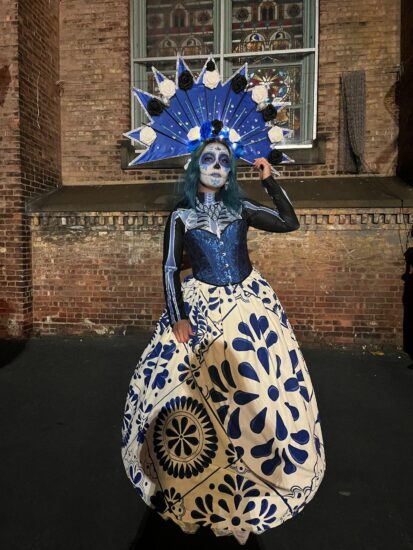Candles lit the brimming streets of Melrose Avenue and women dressed as Catrinas, their faces painted like skulls, marched to honor their beloved dead at seventh annual festival del día de los muertos Saturday October 7th.
The march, in the autumn darkness at 6 p.m., had started and ended in the courtyard of the Church of the Immaculate Conception of the Blessed Virgin Mary Roman Catholic Church, where the Mexican Coalition has its office. The Coalition, a group dedicated to supporting the rights of Mexican American children and families by offering civic, cultural, and political integration services, organized the festival which featured performances by the Tonantzin youth dance group and a mariachi band.
Roughly a hundred members of the Mexican community gathered to celebrate the holiday that mingles Aztec religious traditions with the Catholic feast of All Souls Day. In New York, el día de los muertos has become, as well, a celebration of cultural pride and a chance to reflect on the dissolution of boundaries—between living and dead, Mexico and New York, past and future.
Traditionally, people visit the graves of their loved ones on the Day of the Dead. For Mexicans in New York, whose family graves are thousands of miles away, beyond a national border many may never cross again, there is solace in celebrating with fellow Mexican-Americans.

Brenda De Latorre, 28, and originally from the central Mexican state of Michoacán, has worked for the Mexican Coalition for almost a year. This is her first year celebrating the holiday with the organization. She arrived dressed as a Catrina, her face painted with a black and white skull and accented with purple eyeshadow to highlight her features, along with a headband of purple cempasúchil flowers.
“I love that you can go with your family and remember a person that is no longer with us. And you can share stories about this person,” she said.
Marking the day in the Bronx allows people to connect both to their homes in Mexico and their deceased loved ones, explained Jario Guzman, director of the Mexican Coalition, who was brought from Mexico at the age of 12 and now works closely with immigrant communities. “This is a festivity of the gratitude we have for the transition from life to death, and the legacy you left behind.”
Luisa Perez, a member of the Tonantzin dance group, described performing La Bruja, a dance about a witch who goes out on Halloween night, and another dance about the offerings at the ofrenda (altar), where people place photos and mementos of ancestors and the beloved dead.
“We offer them food and to have comidio with them, meaning to share with them a moment,” she said.
Dia de los Muertos in the Bronx has expanded beyond the Mexican community, its ideas of transcending borders and communicating with ancestors resonating with many in the borough. Ana Crispi, originally from the Dominican Republic, proudly wore a carefully hand-stitched Catrina costume, and explained that she learned about Catrina from a Mexican friend who introduced her to Mexican culture about eight years ago.
Mexican street vendors donated cempasúchil flowers, and members of the community submitted photos of their loved ones to be placed on the ten-foot wide ofrenda, presented in the corner of the courtyard of the church. The ofrenda displayed black and white photos of a married couple, portraits of community elders, vibrant images of smiling men and women from America and Mexico, and photos of beloved pets who had passed away.

Jacqueline R., a mother of two children in the dance group, set up a smaller ofrenda as part of the performance. She explained how the ofrenda included bread in the shape of human skulls, a calavera (a skull made of sugar), and some of the deceased’s favorite fruits and drinks—an offering to the dead. Cempasúchil flowers were placed and candles were lit around the altar—to create a portal that connects the world of the dead with the world of the living. The altars include a crucifix to represent that festival goers and the dead alike are in the presence of God.
While Dia de los Muertos looks backwards, remembering people who’ve lived before, the celebration Saturday was dedicated to the future, honoring the New Yorker children of Mexican immigrants.
NYC Commissioner of Immigrant Affairs Manuel Castro said the festival “is what represents us as Mexican people. All the children that were born here can also experience this in this city.”
In an era of rising anti-immigrant sentiment in the U.S., attendees emphasized the festival’s power to affirm their Mexican culture among children raised in America, and help bridge the gap between American and Mexican traditions.
“We know that immigrant families suffer hate crimes. These events are important because it helps heal the trauma that we experience,” said Jario Guzman. “This is a family center festival that embraces our culture.”

